Studio Visit
Step Inside Raqib Shaw’s Secret Garden Studio, Where He Tends Bonsai and Channels His Grief Into Healing New Paintings
The work is on view at the Ca’Pesaro through September 25.
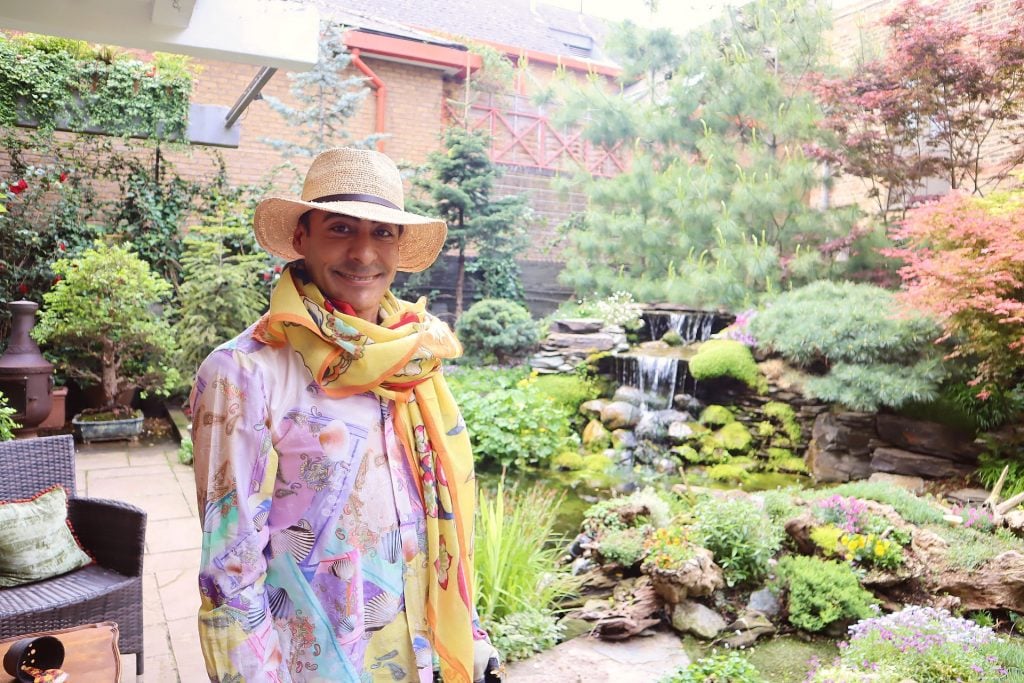
The work is on view at the Ca’Pesaro through September 25.

Naomi Rea

I met Raqib Shaw in the garden. As the artist greeted me effusively, decked out in gardening regalia and a colorful scarf, he reminded me of somebody’s genteel grandmother. Holding a wicker basket in the crook of his arm, he beckoned me conspiratorially to follow him further into the oasis that is his studio garden.
During lockdown, Shaw built an elaborate rock garden in his backyard, which he has used as the backdrop for several new paintings currently on view at the Ca’Pesaro in Venice. From the outside, you’d never know such splendor lay beyond the walls of this former sausage factory in a slightly grim neighborhood of southeast London.
Over the course of his 23-year career, the Kashmir-born artist has become known for intricate, large-scale paintings from life that carry the sweep of Old Master tableaux but are made using industrial paints and enamel. Unlike the assembly-line operations run by other big-name artists, Shaw’s live-work studio setup is a relatively humble affair, with just a smattering of assistants on hand when I visited. He told me he strived to cultivate the atmosphere of a Renaissance atelier with his protégés. The 12 paintings currently on view in “Palazzo della Memoria,” certainly take on a Renaissance heft. The Retrospective, the most ambitious of the lot—which was in production from 2015 until a few days before the exhibition opened—in particular rewards close looking.
Shaw insisted I make myself comfortable in the inner sanctum of the bonsai house, where dozens of the manicured trees sat beneath their own personal spotlights. While he prepared me an Alphonso mango shake—because “Simply no other mangoes will do!”—I reflected on his theatrical demeanor. So determinedly bright, it struck me as the kind of protective measure of someone who is actively working to keep others at arms’ length. To maintain such a manicured outward appearance, as with the delicate trees he tends, takes a lot of discipline—and perhaps, he later confided, a certain degree of masochism.
As we spoke, however, it unfolded that the artist was still reeling from a heavy loss, and that there was a loneliness and sadness tinging what to the outside world largely appears to be a serene and lovely life.
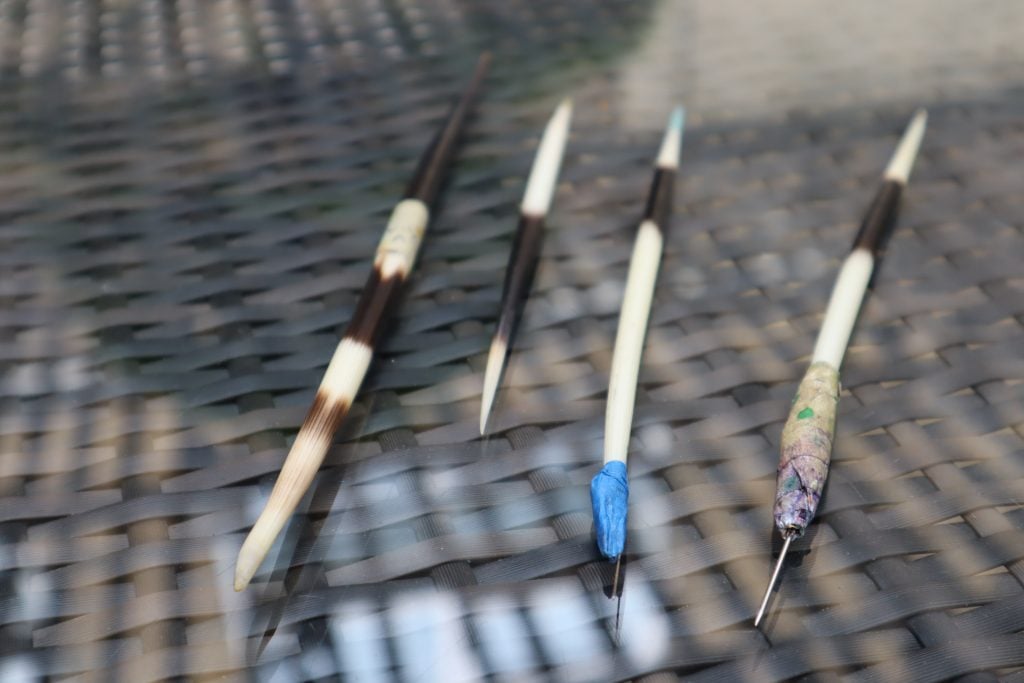
Porcupine quills at Raqib Shaw’s studio. Photo: Naomi Rea.
What is the most indispensable item in your studio and why?
The porcupine quills! When I first started working with the materials that I work with, I realized I needed something small and splintery. It used to be matchsticks, in my college days, 20-something years ago. And then one fine day, when I was squatting in Percy Dalton’s Peanut Factory Studio in Hackney Wick, one of my friends—she’s dead now—sent me this package, and there was a little note from her that said: “These were left outside my tent in Botswana by some fighting porcupines, and I thought that they might help you with your paintings.” What a clever idea: the porcupine quill is light, it’s pointy, and you can sharpen it because it’s basically hair, so it gives you the most incredible control. I couldn’t do without it.
Where do you get them now?
eBay! And we are told that they are procured in a humane way, because, you see, they shed all the time.
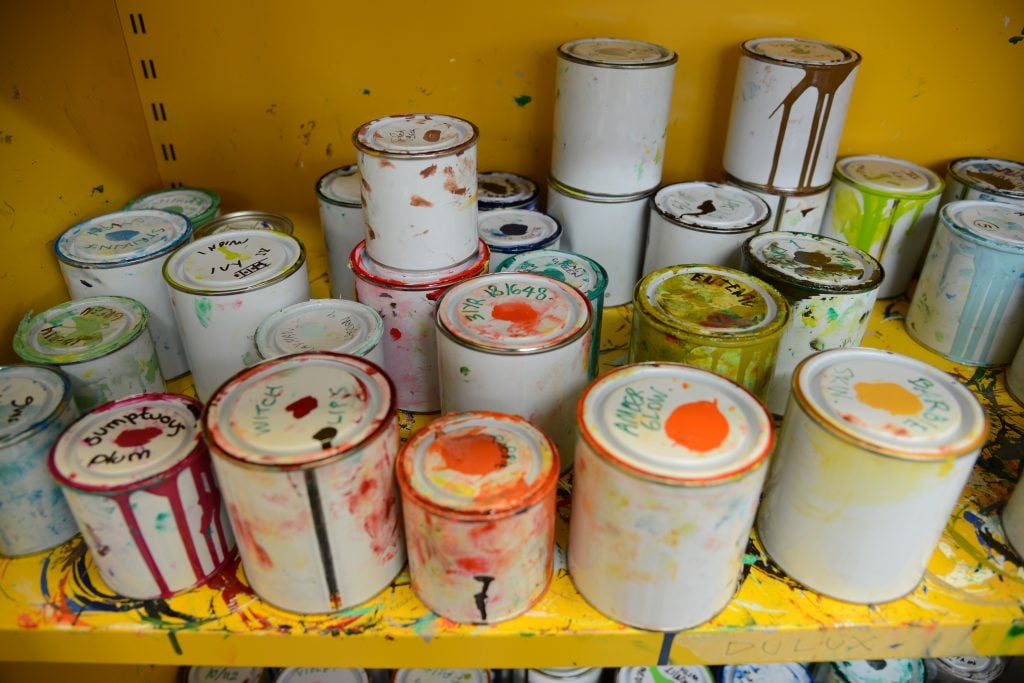
The paint-mixing room. © Raqib Shaw.
Material is really important for you, and I know that a lot of people during lockdown had a real nightmare getting their hands on certain materials. Was that an issue for you?
Not really. The fact is that we have so much paint here because it’s so cheap. I have paints that go all the way back to my college days, so we do have a fabulous stock.
Another thing was the plants. Everything does appear in the paintings because these are life studies. During lockdown I couldn’t believe it: the nurseries were still open. Within two hours’ drive, I had been to every single nursery, and it was really fabulous that I was able to compose while keeping the paintings in mind. When they all flower, they are exactly as you see in Agony in the Garden. And when they see them, everyone says, “That can’t be England.” But it is England!
Lockdown was in many ways the most blissful period in my life. I could finally address the rockery. And the bonsai loved it because they love to be pampered, and for the first time in many years, I was able to look after them every day.
The bonsai are pretty special. When did you begin your collection?
Around 14 or 15 years ago, and purely by chance. I got one from Japan because in those days, it was easy. I used to know this guy who would smuggle them through Scotland—his name was Douggie—and he would have a collection of plants and these were smuggled within the plants. And now it’s impossible because there is quarantine and too many regulations. So now it’s very difficult, especially because of the pandemic.
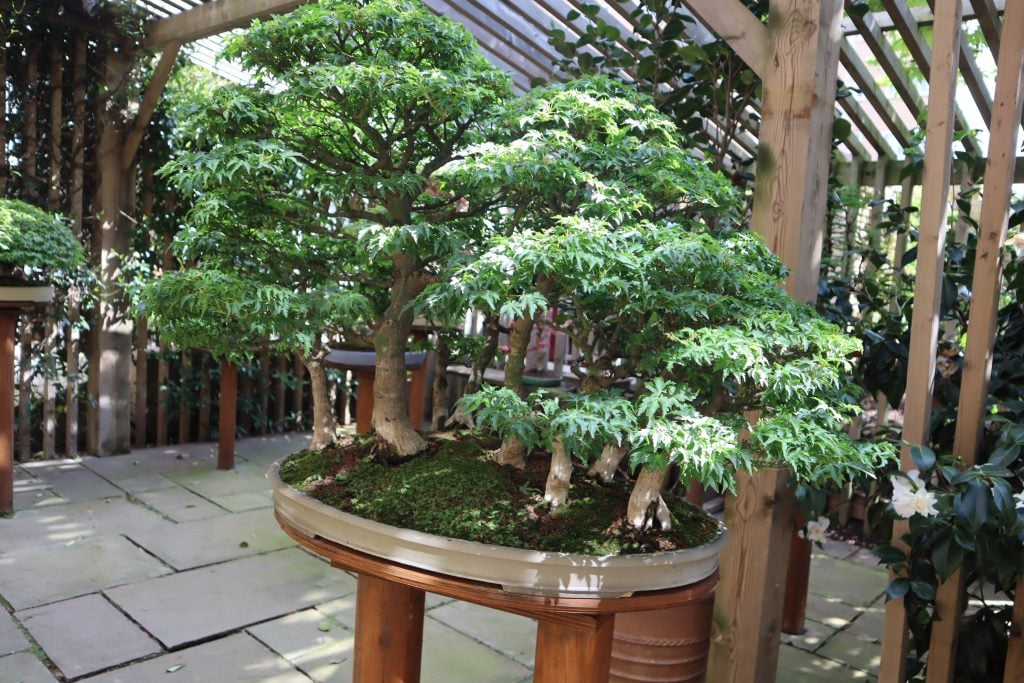
Raqib Shaw’s studio. Photo: Naomi Rea.
And I see they are all individually lit so they will get their special moment.
I think you’ll have to come at night, because they are individuals in that they have their own likes and dislikes. I know this sounds weird, but it is so true. They’re very, very sensitive and one does have a very specific, personal relationship with each one of them. Some of them are easy. Some of them are extremely difficult. And some of them, if you don’t give them the right kind of attention at the right time, they just become upset. But the reason I have them is that before my dog died, I never really went out of the studio. So I could look after them all the time.
Your dog Mr. C features in the paintings in Venice.
Lockdown was tough for me. I lost my cousin who died in a car accident, and that was the only person who I related to as family, so there was my family gone. I’ve never been in a relationship, and then my dachshund died and then my Jack Russell died, and suddenly I woke up one day and there was absolutely no one in this world.
What I was slightly annoyed about is that no one ever told me what loss and the grief that follows is all about. Yet it did change my perspective. And now when I see people, I feel that if this person has been through what I’ve been through, this person deserves my love. And if this person hasn’t, he will, or she will. They deserve our sympathy.
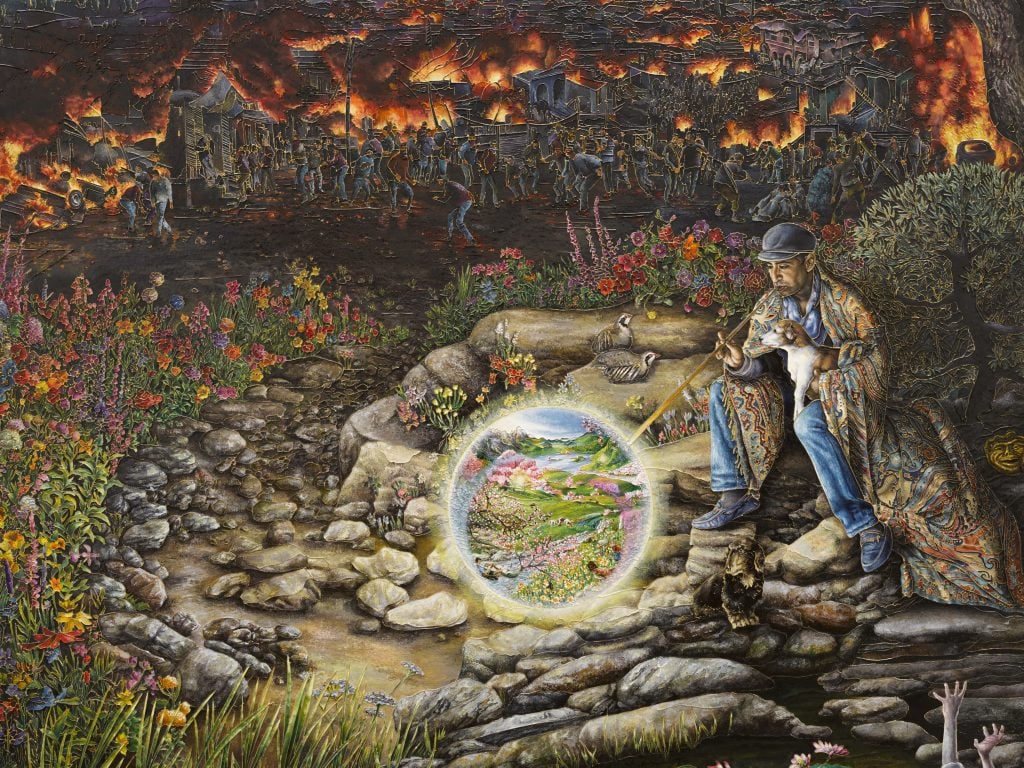
Raqib Shaw, La Tempesta (after Giorgione) (2019). © Raqib Shaw. Photo: © White Cube/Theo Christelis.
It’s interesting to hear you speak of loss like that, coming from your background in Kashmir. The works on view in Venice powerfully evoke a sense of the region as a lost homeland and heritage.
I think something, be it animal, be it human, the one that you nurture somehow is very, very special. I think I never knew what parenthood was all about. But I think this is the closest to that. And I think that it is that pain because I think that we are not designed to accept that our children will die before us.
It was terrible. I still can’t sleep continuously every night. And what’s incredible is that whatever happened, it completely transformed the paintings. I know this is really terrible, but I do consider this group of work my best paintings ever, because I wasn’t painting for the sake of painting. I was trying to heal myself through paintings and find refuge in them. And the only thing I kept thinking is that people who don’t have things like painting, how do they live? How do they deal with this terrible situation? Because I could just go into the world of paintings and just do my therapy there.
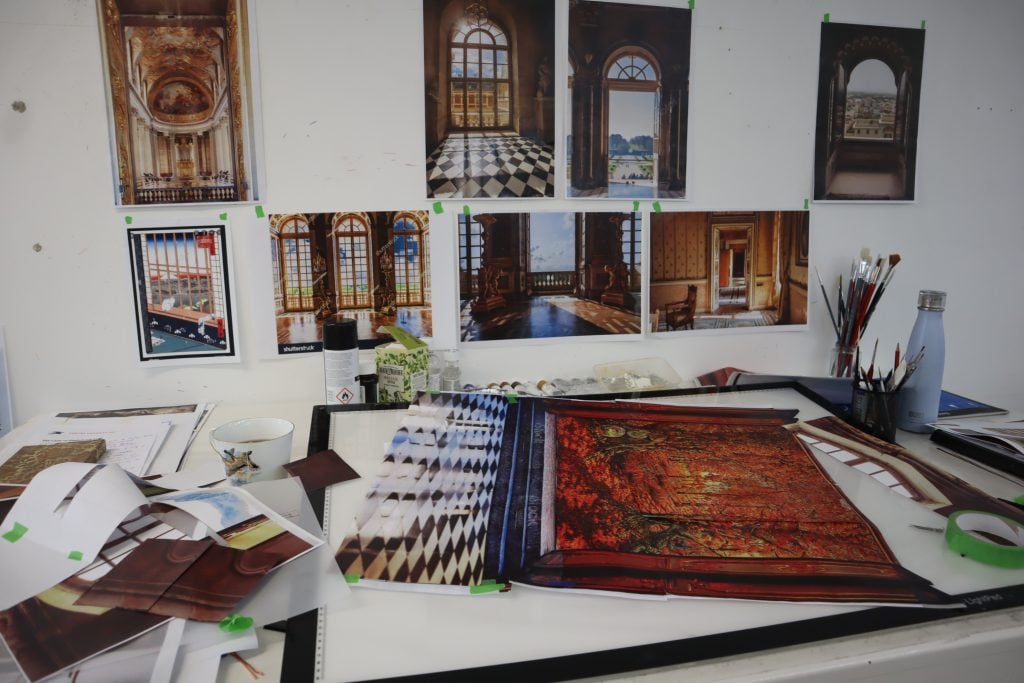
Raqib Shaw’s studio. Photo: Naomi Rea.
What is a studio task on your agenda this week that you are most looking forward to?
I’m most looking forward to consolidating the concept and the compositions for my next show in Seoul, with Thaddaeus Ropac gallery. I’m really excited about it because I had a “Eureka!” moment yesterday, and I could see the paintings. I think this is the body of work is going to be around the fate of the Lady of Shalott. All the kids here, they laugh, because they say, “She sounds like you.” But I think there shall not be any Lancelot on his horse for me…
What kind of atmosphere do you prefer when you work? Do you listen to music or podcasts, or do you prefer silence? Why?
Silence. I always used to listen to music, but lately, in the last few years, I have loved to listen to silence. It’s never true silence, because we live in the middle of Peckham, but it has much improved—12 years ago it was very noisy, but then you see the trees grew. That line of trees behind you is a Magnolia grandiflora. They remind me of my grandfather’s house, in Kashmir. And these trees—I’m ridiculous—these are not the usual plain trees; the really old ones have a spread of half a kilometer. And you know what? Let them grow.
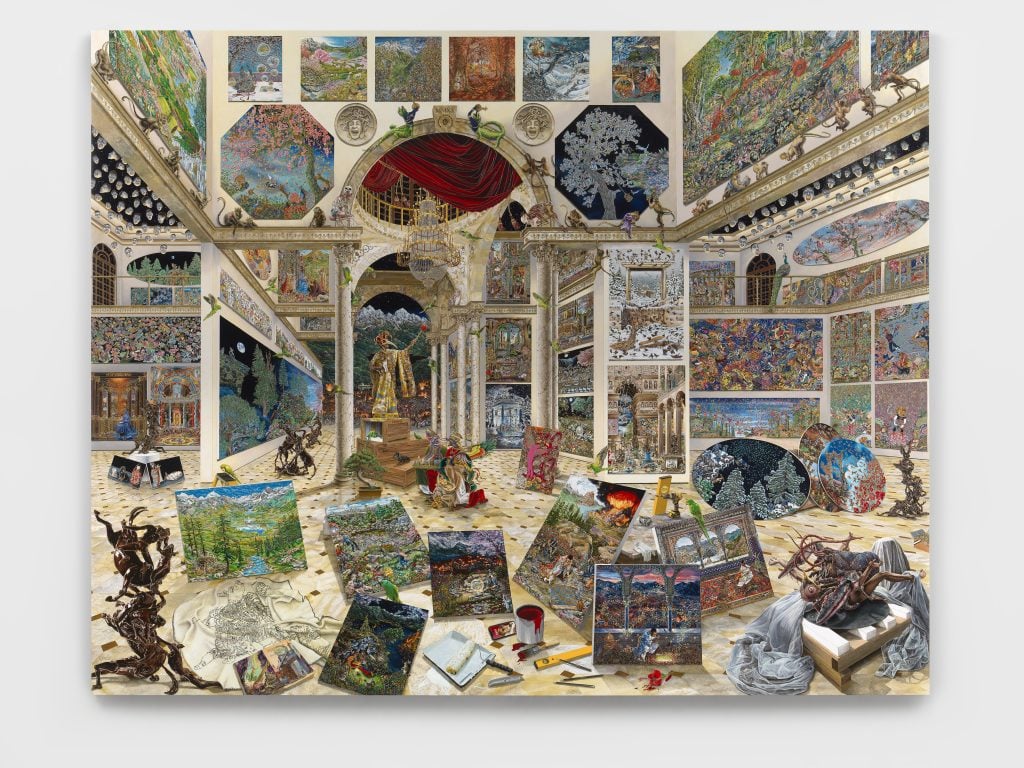
Raqib Shaw, The Retrospective 2002–2022 (2015–22). © Raqib Shaw. Photo: © White Cube/Todd-White Art Photography.
In your current exhibition at the Ca’Pesaro in Venice, you’ve taken inspiration from pictorial traditions of Venetian and Italian masters, from Tintoretto to Panini. When did you first encounter these works?
I’ll tell you exactly when I decided to be a painter. I came here in 1992 as a teenager. My family had businesses here, and I was being groomed to be like the rest of the family. Indian families are notoriously terrible for holding everyone together, doing the same. It’s the same mentality as a corner shop. And so I was supposed to be like everyone else and be a part of the family business, merchants. And for the first time in my life, I went to the National Gallery and I saw The Ambassadors, and I just fell in love with that painting. I thought to myself that instead of being the merchant, I would like to be the one who paints the merchants. That was actually when I decided that I was going to be a painter, but then it took me about four to six years to negotiate my release from my family.
When you feel stuck while preparing for a show, what do you do to get unstuck?
I really don’t get stuck, can you believe it? The thing is about being stuck—I know it sounds weird—but something happens…I call it the “goddess of art.” It might sound absurd, but when one is in the right frame of mind and when one is together in that zone, things happen. But to get into that zone, sometimes it takes a long time.
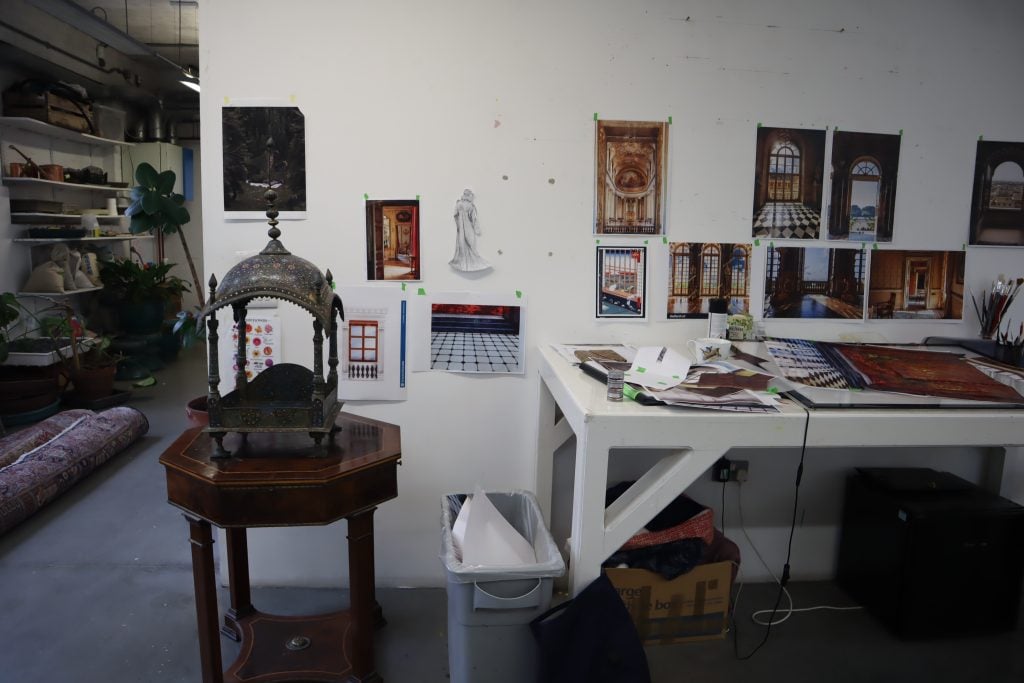
Raqib Shaw’s studio. Photo: Naomi Rea.
What trait do you most admire in a work of art?
I think the quality to transport me somewhere and to make me feel something that I haven’t felt before. Like a portal to another world, and to go into that world, I think that’s quite fascinating. I love that.
What trait do you most despise?
“Despise” is a strong word. I just don’t engage with pretentious works that over-intellectualize something. And I don’t engage with paintings that try to be popular or try to be fashionable. Because I think one has to be extremely true to oneself as a painter; you can never, ever hide.
What images or objects do you look at while you work?
That depends on what I’m working on. For example, the last of the paintings is called The Departure. You have all the objects from my studio—specifically the model of the Temple of the Golden Pavilion, because Yukio Mishima wrote a lovely book about it and that features in the painting—and other pieces that I associated with that period with my dog.
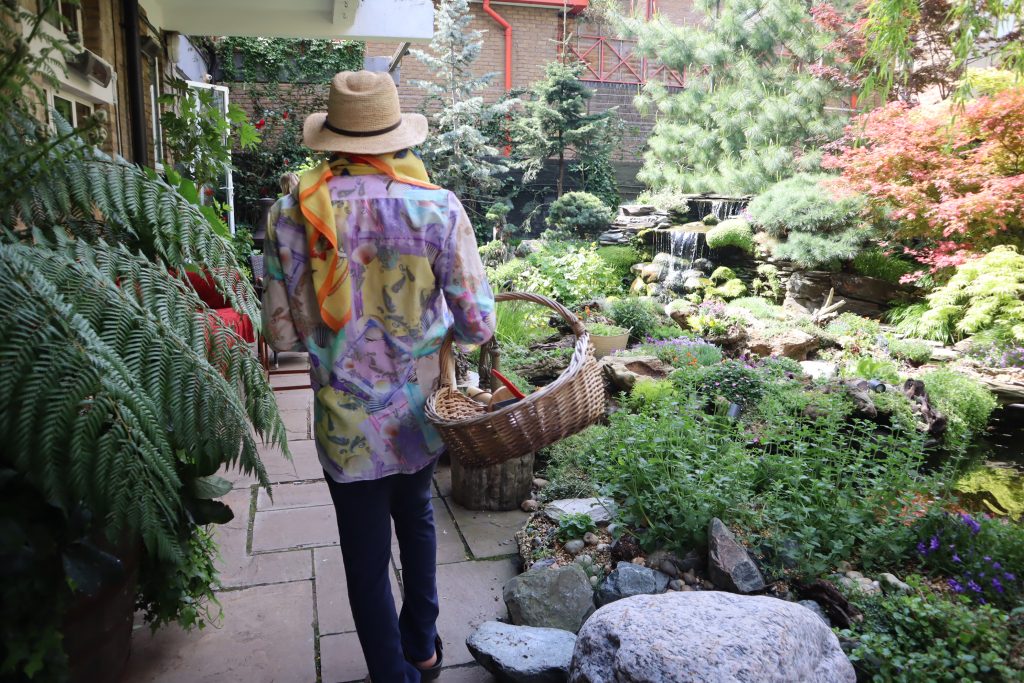
Raqib Shaw. Photo: Naomi Rea.
What is the last exhibition you saw that made an impression on you and why?
The last one that I went to with Norman Rosenthal, who curated my show in Venice. For the first time in my life, I went with Norman to the Accademia, and we went to see Giorgione’s La Tempesta, and he said, “Why don’t you do your version?” And I laughed my sides out because it is considered the Mona Lisa of Venetian art and the holy grail that no one touches. And then I thought to myself, you know what? I’m going to give it a try. And if it fails, it fails. I really don’t care if things don’t work, because it’s all a journey.
What’s coming up next for you?
Aside from preparing for the exhibition in Seoul, I will have a traveling exhibition in America, first going to Nashville at the Frist Art Museum, and then it should travel to the Isabella Stewart Gardner Museum in Boston, and then it will go to the Huntington in Los Angeles. And for all these three museums I’ve been asked to make two or three works as my response to the museums and the places, so I am looking forward to spending some time in residency there.
Organized in collaboration with White Cube, “Raqib Shaw: Palazzo della Memoria” is on view at the Fondazione Musei Civici di Venezia, Ca’ Pesaro – Galleria internazionale d’arte moderna in Venice, through September 25.